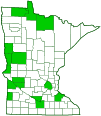white prairie aster
(Symphyotrichum falcatum var. commutatum)
Conservation • Wetland • Description • Habitat • Ecology • Use • Distribution • Taxonomy
Description |
White prairie aster (var. commutatum) is an erect, perennial forb. It usually rises a single stem from a long rhizome. Sometimes it rises on 2 to 5 or more clumped stems from a group of short, entangled rhizomes. New shoots develop at the end of elongated rhizomes. A mature plant can be from 4″ to 31″ tall, though in Minnesota it is usually no more than 24″ in height. It is usually found in colonies. The stem is ascending to erect, grayish-brown to brown, and usually branched above the middle. It is usually densely covered with short, upward-curved hairs. The stem is green when young, becoming grayish-brown to brown when the plant matures. Basal leaves are ⅜″ to 1½″ long, ⅛″ to ⅜″ wide, inversely lance-shaped, firm, and stalkless. They are tapered at the base and rounded or angled at the tip with an abrupt, short, sharp, hard point at the tip. The upper and lower surfaces are rough to the touch and usually sparsely to moderately covered with straight, stiff, sharp, appressed hairs. The margins are usually untoothed and have a fringe of spreading or forward-pointing hairs. By the time the plant is in flower the basal leaves have withered. Lower stem leaves similar to basal, alternate, inversely lance-shaped to oblong, ⅜″ to 1½″ long or longer, 1 ⁄16″ to ⅛″ wide or wider, becoming progressively smaller as they ascend the stem. They are wedge-shaped at the base, rough to the touch, and are sparsely to densely covered with straight, stiff, sharp, appressed hairs. Upper stem leaves similar to lower, linear oblong to linear lance-shaped, 1″ to 1¾″ long, and 1 ⁄16″ to ⅛″ wide. Leaves on the branches are evenly distributed around the branch, notarranged on one side of the branch. The inflorescence is an elongated, branched cluster (panicle) of usually 10 to 200 or more flower heads at the end of the stem and branches. The panicles have short to long, ascending branches with 1 or a cluster of 2 to 10 or more uncrowded flower heads per branch. The flower heads are usually clustered at the end of the panicle branch, and are not arranged on one side of the branch. The flower heads and clusters are on stout, up to 2″ long stalks (peduncles). The stalks have 2 to 10 or more somewhat leaf-like bracts. The bracts are ⅛″ to 5 ⁄16″ long, linear to lance-shaped, and densely hairy. The flower heads are ⅜″ to ¾″ in diameter. The whorl of smaller bracts subtending the flower head (involucre) is bell-shaped. The bracts of the involucre are linear lance-shaped to oblong inversely lance-shaped, thickened toward the base, abruptly bent backward, and tapered at the tip with a short, sharp, spine-like point at the tip. The margins of the bracts have a dense fringe of spreading hairs. The flower heads have 15 to 35 (usually at least 20) ray florets and 8 to 30 (usually at least 18) yellow disk florets. The ray florets are usually white, rarely pink or blue. The disk florets become brown with age. The fruit is an achene with a tuft of whitish hairs at the tip. |
Height |
4″ to 24″ |
Flower Color |
White ray florets, yellow disk florets |
Similar Species |
White prairie aster (Symphyotrichum falcatum var. falcatum) rises in tufts of 1 to 5 or more stems from a short, solid, woody, underground stem. New shoots develop near the bases of old stems. The stems are sparsely covered with straight, stiff, sharp, appressed hairs. The peduncles are long and slender and have no more than 5 bracts. |
Habitat |
Dry to moderate moisture. Prairies, meadows. Full sun. |
Ecology |
Flowering |
August to October |
Pests and Diseases |
|
Use |
|
Distribution |
||
|
Sources |
|
| 3/18/2024 | ||
Nativity |
||
Native |
||
Occurrence |
||
|
||
Taxonomy |
|
Kingdom |
|
Division |
Tracheophyta (Vascular Plants) |
Subdivision |
Spermatophytina (Seed Plants) |
Class |
|
Order |
Asterales (Sunflowers, Bellflowers, Fanflowers, and Allies) |
Family |
Asteraceae (Sunflowers, Daisies, Asters, and Allies) |
Subfamily |
Asteroideae |
Supertribe |
Asterodae |
Tribe |
Astereae (asters and allies) |
Subtribe |
Symphyotrichinae |
Genus |
Symphyotrichum (American asters) |
Subgenus |
Virgulus (virguloid asters) |
Section |
Ericoidei (white heath and prairie asters) |
Species |
|
This and other asters were formerly place in the genus Aster. That genus was problematic, in that it did not include just one common ancestor with all of its lineal descendants and no others – it was not monophyletic. In 1994, the genus Symphyotrichum was resurrected to include most North American asters formerly in the genus Aster. |
|
Subordinate Taxa |
|
|
|
Synonyms |
|
Aster biennis Aster commutatus Aster commutatus ssp. crassulus Aster commutatus var. crassulus Aster cordineri Aster crassulus Aster ericoides var. commutatus Aster falcatus ssp. commutatus Aster falcatus var. commutatus Aster falcatus var. crassulus Aster incanopilosus Aster multiflorus var. commutatus Symphyotrichum falcatum ssp. commutatum Symphyotrichum falcatum var. crassulum Virgulus falcatus ssp. commutatus Virgulus falcatus var. commutatus |
|
Common Names |
|
white prairie aster |
|
Glossary
Achene
A dry, one-chambered, single-seeded seed capsule, formed from a single carpel, with the seed attached to the membranous outer layer (wall) only by the seed stalk; the wall, formed entirely from the wall of the superior ovary, does not split open at maturity, but relies on decay or predation to release the contents.
Bract
Modified leaf at the base of a flower stalk, flower cluster, or inflorescence.
Involucre
A whorl of bracts beneath or surrounding a flower, flower head, or flower cluster.
Linear
Long, straight, and narrow, with more or less parallel sides, like a blade of grass.
Panicle
A pyramidal inflorescence with a main stem and branches. Flowers on the lower, longer branches mature earlier than those on the shorter, upper ones.
Peduncle
The stalk of a single flower or flower cluster.
Rhizome
A horizontal, usually underground stem. It serves as a reproductive structure, producing roots below and shoots above at the nodes.
Visitor Photos |
||
Share your photo of this plant. |
||
This button not working for you? |
||
|
||
|
||
MinnesotaSeasons.com Photos |
||
Plant |
||
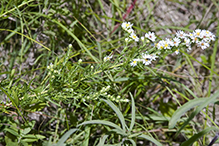 |
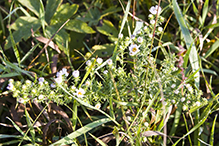 |
|
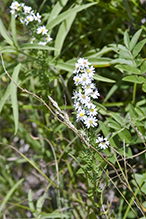 |
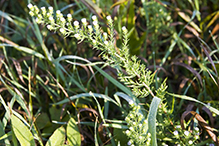 |
|
Inflorescence |
||
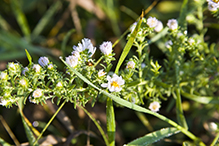 |
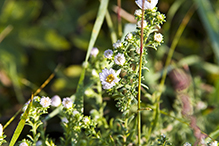 |
|

Slideshows |
|

Visitor Videos |
||
Share your video of this plant. |
||
This button not working for you? |
||
|
Other Videos |
||
|

Visitor Sightings |
||
Report a sighting of this plant. |
||
This button not working for you? |
||
|
|
MinnesotaSeasons.com Sightings |
||

Created: Last Updated: © MinnesotaSeasons.com. All rights reserved. |
